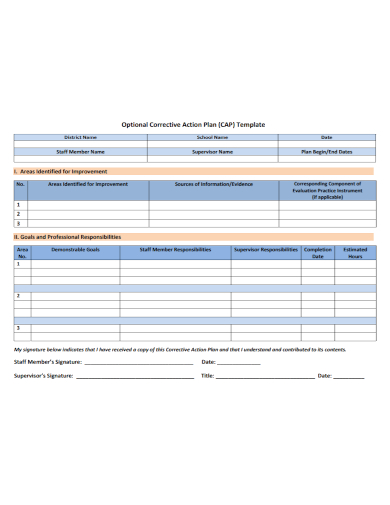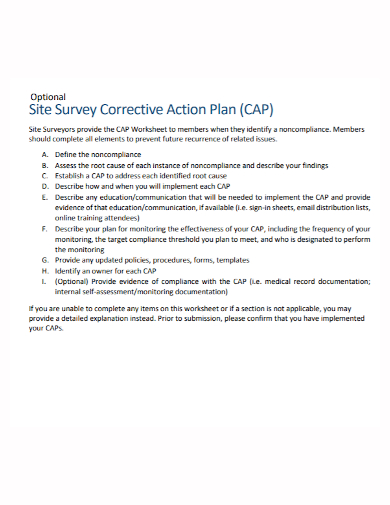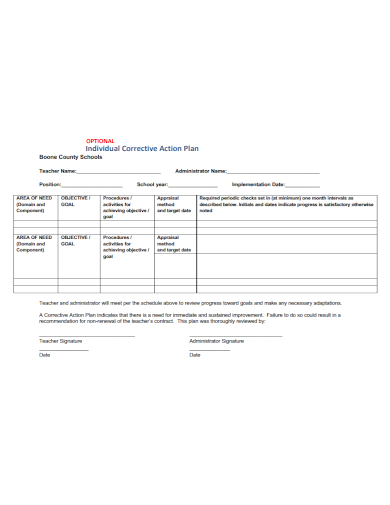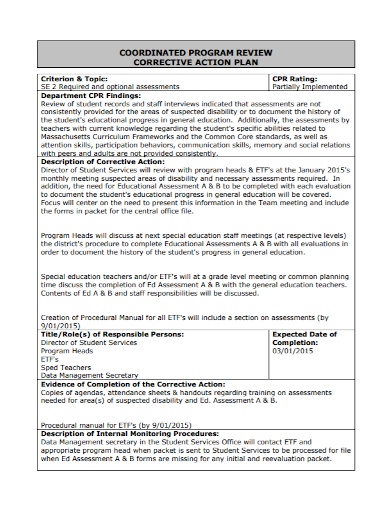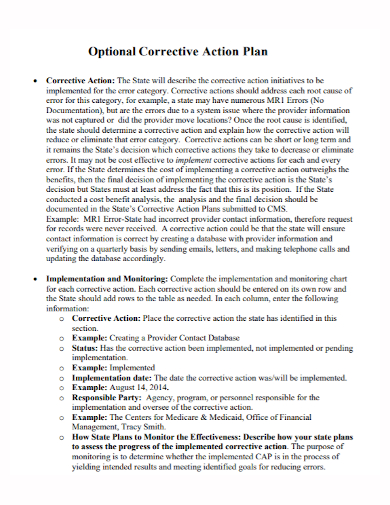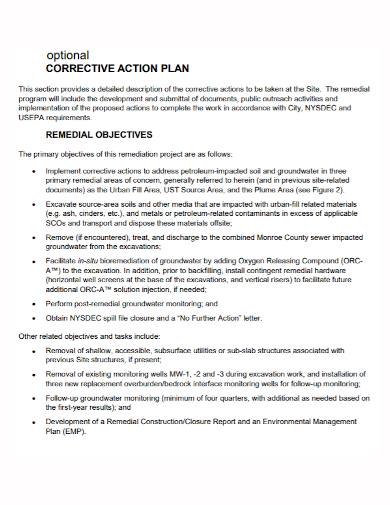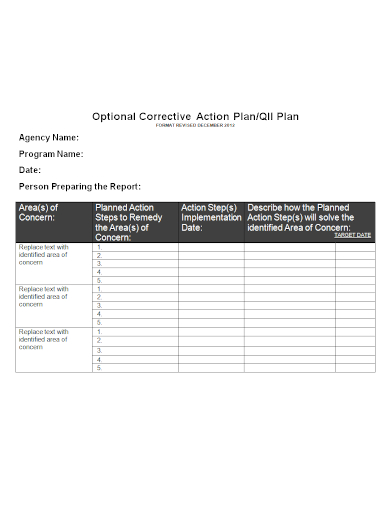Every business or company needs to be able to come up with a comprehensive layout or a plan of their own to guide every project, task, or venture that they are set to accomplish. Being able to do so will help in keeping the entire management and the rest of the organization on track for a lot of things that may or may not be encountered during the overall project development. Planning ahead is always good business practice, especially when you have a project that aims to develop the parameters set within your company. Making sure that all of your operations are foolproof. That is the purpose of a corrective action plan. A document that highlights the important steps that the management can take ahead of time to make sure that the intervention that they are planning to establish in the company is actually effective. Well written action plans go massive lengths in bringing the entire idea together, turning mere vision into actual reality and progress.
It’s always important to be able to plan ahead of time because most of the time it’s what makes or breaks your venture. As the saying goes, not planning at all is planning to fail. Action plans essentially allow you and your project developers to provide pointers to your organization early on, giving them a heads up on what needs to be done and what needs to be accomplished. It makes sure that everybody has the time they need to prepare, gather the resources that they need to work, and encourage most if not all employees to be involved with the intervention.
Writing an action plan may not really seem much, but that’s not really the case most of the time. Especially for corrective action plans where the general objective is to establish these supporting parameters and protocols within your own company to lower the possibility of breaches and discrepancies, and define general accountability. It can be quite a lot of responsibility within a single document, but that’s the point, and that’s the reason why the writing process warrants care and attention to detail. Before you begin writing your action plan, check out these optional corrective action plan samples first to acquaint yourself with the document. See how it looks and how it works. Once you are quite familiar with it, feel free to use these samples as guides or even as templates for when you write an optional corrective action plan on your own.
8+ Optional Corrective Action Plan Samples
1. Optional Corrective Action Plan
2. Sample Optional Corrective Action Plan
3. Optional Site Survey Corrective Action Plan
4. Optional Individual Corrective Action Plan
5. Optional Program Corrective Action Plan
6. Optional Implementation Corrective Action Plan
7. Cattle Assessment Optional Corrective Action Plan
8. Optional Remedial Corrective Action Plan
9. Agency Optional Corrective Action Plan
What Is an Optional Corrective Action Plan?
Corrective action plans work quite just the same as regular action plans. Both kinds of documents contain the strategies, details, and the outline of numerous components and parameters that a company might put in place for the overall planning and implementation of the project. Regardless of what the task is, it’s size, shape, or form, when project developers want whatever they are doing to succeed, then writing an action plan may be the best initial step that they can take. While most action plans consist of only a couple pages, the length of the document largely depends on the nature and scope of the project that the document will cover. Corrective action plans may have quite a wider scope since it aims to fix a discrepancy within the operations of a company. That depends which business operations that cover, from marketing, financial to operational. The steps and actions that are within the action plan should be coupled with enough details and specifications to make sure that whoever is assigned to work on the project can immediately know what they should do and how they are supposed to do it. Vagueness and unnecessary work jargon are highly discouraged when writing an action plan, since it has the tendency to cause more confusion rather than actually clear things up. It would be a whole lot better if you just used a simple language that everybody can easily understand and comprehend. The document doesn’t even have to be flashy nor colorful, just some well placed visuals here and there should be more than enough to alleviate the crudeness of the plan without it going overboard. Corrective action plans may not seem much, but once you actually begin using it, you’ll quickly see the wonders it can bring.
How to Write an Optional Corrective Action Plan
Writing an action plan is more than just jotting down tasks and steps on a piece of paper. The first thing you’ll need to keep in mind is that you have to have a clear idea of what your projected results are, and how you plan to achieve those goals. Then explain that process to your entire team to make sure that everyone who is affiliated with the project knows exactly where you’re heading and how you intend to get there. There are several steps that you need to follow and keep in mind to make sure that this is so. These steps are listed and discussed below, as well as some pointers that we hope can help you in writing an action plan.
- Define your goal
Before you actually begin writing your action plan, think about what your goal is first. A clear goal carves its own path. Diving into a venture completely blind without a proper idea of where you’re heading will only set you up for failure. You need to analyze the situation first and as well as the circumstances that you are in. Set SMART objectives to assess your goals better and see if it is feasible or not.
- List down the steps
Enumerate the steps that you think are necessary to reach the objective that you have set. Don’t think about the order of these steps just yet, what’s important here is that you identify all of the things that need to be done. Give details and provide enough context to make sure that these tasks are done exactly the way they are supposed to be done.
- Prioritize tasks and deadlines
Once you’ve enumerated the tasks, organize them according to what needs to be completed first and those that are both labor and resource intensive.
- Set milestones
Setting milestones along the way will boost your team’s motivation by giving them something to look forward to despite the completion date still quite some time away. Patting yourselves in the back from time to time is just objectively good, especially when trying to encourage your team to continue pushing forward. Small victories slowly accumulate overtime, just make sure that your progress is consistent all throughout.
- Identify the resources that you need
Gather and prepare the resources that you will need ahead of time. Doing so will let you focus entirely on developing the project, rather than stopping midway because of shortage of supplies. It’s better to work with more of what you need than less.
- Visualize your plan
Aside from establishing the tasks and the activities that need to be completed, your action plan also has to be able to communicate the elements that you have identified early on. State the risks that you might face, the tasks, chain of command, assignments, deadlines, and the whole inventory of your supplies. Visualizing the plan will help you see if it’s possible to work with the components and the circumstances that you are currently working with.
- Monitor, Evaluate, Update
Action plans are a ‘live’ document. The writing process does not simply stop when you’ve put all of your elements into paper. The plan needs to be updated and changed regularly, depending on how these elements change and evolve over time.
FAQs
What are the five steps of an action plan?
Corrective means tending or intended to correct or counteract or restore to a normal condition.What does corrective mean?
What are the five SMART objectives?
A well written and well drafted action plan can do wonders for your company. Especially in making sure that the goals that you have identified have a good chance of actually being fulfilled. It keeps things smooth. And while issues still surface, everyone that is working with the organization is fully equipped with everything they need to tackle the problem.
Related Posts
FREE 12+ Sample School Action Plan
FREE 12+ Construction Action Plan Samples
FREE 12+ Sample Employee Action Plan
FREE 10+ Education Action Plan Samples
FREE 10+ Health Care Action Plan Samples
FREE 10+ Nursing Action Plan Samples
FREE 9+ Training Action Plan Samples
FREE 8+ Sample HR Action Plan
FREE 7+ Sample Employee Disciplinary Action Forms
FREE 6+ Child Protection Action Plan Samples
FREE 38+ Sample Action Forms
FREE 38+ Example of Action Plans Samples
FREE 10+ Risk Management Action Plan Samples
FREE 10+ After Action Plan Samples
FREE 10+ Environmental Action Plan Samples

